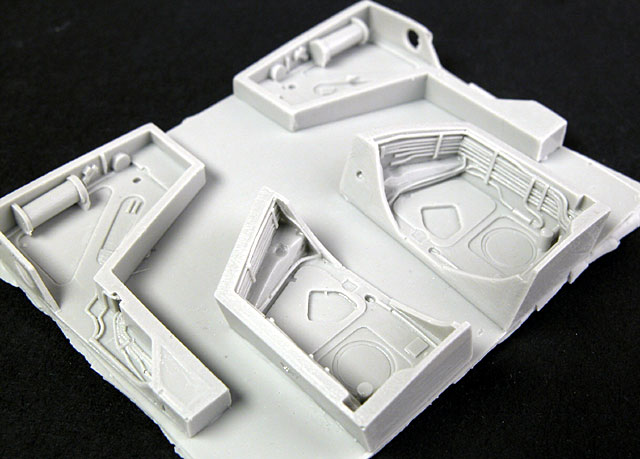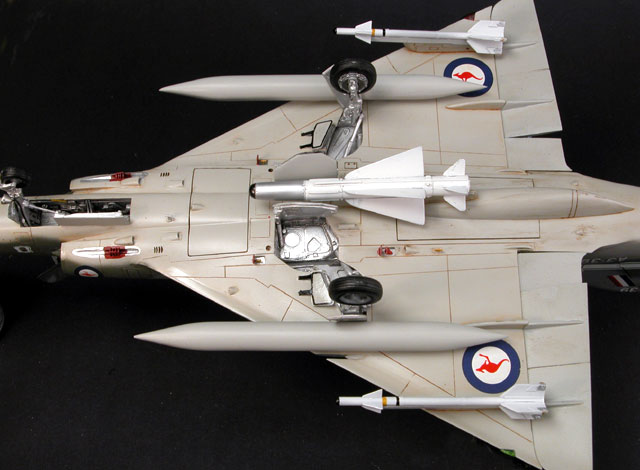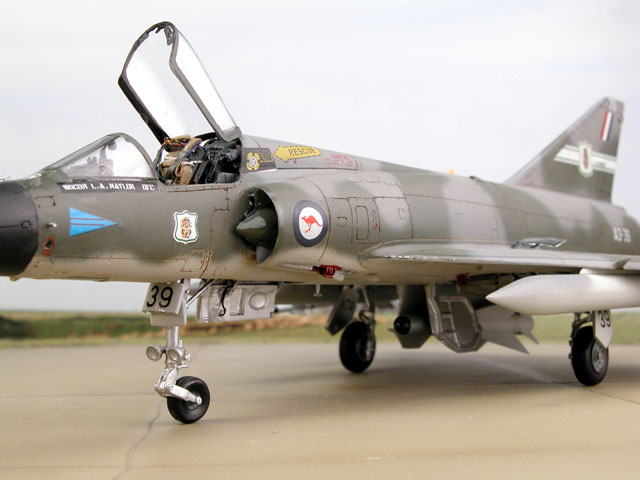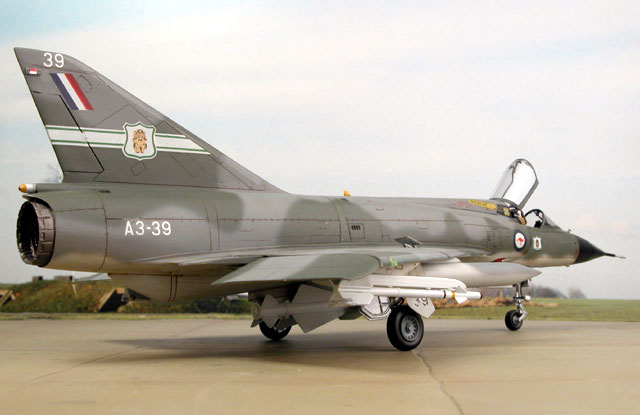|
Dassault Mirage IIIO
by Mick Evans
|

|
|
Martin-Baker M.B.5 |
images by Brett Green

Fonderie
Miniatures' 1/48 scale Mirage IIIE is available online at Squadron.com
This is Fonderie Miniature's 1/48 Scale Mirage IIIE converted to RAAF
III0.
The Fonderie Miniature kit is the best representation of the Mirage IIIE
in 1/48 scale to this date. FM has included a full Heller 1/48 scale
Mirage IIIC kit with a new limited run injection moulded IIIE fuselage,
and a host of super detailed resin and metal parts.

Click the thumbnails below
to view larger images:
Having built all of the kits and conversions for the Mirage IIIO that
have been available over the years, converting this IIIE to a IIIO was
not only easy it gave the most accurate kit in one box that I have seen
so far.
Brett
Greenís in-box review elsewhere on HyperScale details all the parts,
but I will go further to say that the cockpit is almost perfect for a
IIIE, and the wheel wells, and engine afterburner nozzle have every
piece of detail possible. The only extra detail that I added was the
brake lines to the main undercarriage legs, and a prominent electrical
cable to the nose leg.

The main difference between the IIIE and IIIO cockpit is the PHI
indicator on the right hand instrument panel, a few scrapes of the
knife, and the addition of some detail, and the conversion was complete.
Assembly of the kit requires the wheel well detail to be removed from
the Heller wings and then some serious thinning of the inner surface of
the top and bottom wing halves to allow the resin undercarriage bays to
fit.
I elected to remove the speed brakes so that I could display them in the
cracked open position. This position is common as the pilot exercises
the speed brakes to bleed the hydraulic power off the systems after
every flight, to render the aircraft safe to work around. The Heller
wings have raised panel lines while the FM fuselage has recessed panel
lines, so some time was spent re-scribing the wings. The elevons and
pitch dampers were removed at this point, because without hydraulic
power the elevons droop down to the limit stops.
The instructions show small wedges of plastic that are required to be
removed on the fuselage inlet mounts, this was obviously a limitation in
the moulding process. This proved to be a delicate task.

Next my attention was drawn to thinning down the cockpit and nose
wheel bay area to allow a good fit. Constant trial fitting is a must
throughout the entire build process. The rear end around the afterburner
outlet is the other area that requires thinning also. The afterburner
was trial fitted, with some support mounts being made from scrap sprue
to allow the afterburner to be fitted late in the assembly.
The fuselage was cleaned up on a sheet of wet and dry paper taped to a
flat surface and then assembled with the cockpit and nose wheel well
installed and left to dry. The fuselage area near the cut out for wings
had to be spread later using some scrap sprue as kept collapsing
inwards, a problem caused by the moulding process. The spreading process
was continued until the wings mated with the fuselage perfectly. The
scrap sprue spreaders were then superglued into place.
The upper wing to fuselage join was so good that no filler was require,
but there was a 2mm gap at the lower rear wing to fuselage join. This
was solved with strips of plastic card and filler.
The rest of the build was straight forward from this point.
The bulbous antenna housing under the nose for the doppler system was
replaced with a scratch built flat panel made from plastic card. All the
antennae and probes were scratch built using plastic card and rod.

I chose to model the IIIO in the early 1980s, this meant that the
model would have the MK4 seat and AIM 9B Sidewinder missiles provided in
the kit fitted rather than the MK6 seat and Matra 550 Magic Missiles
fitted post 1981/2. The seat is quite representable but has no harness
moulded or supplied, and the AIM 9B missiles are simply awful. The
missiles were replaced with Hasegawa AIM 9Bs.
The seat was modified by making the parachute pack look more like the
horseshoe shape that it is, and the harness was made from lead foil.
This involved making the shoulder harness from four layers to represent
the real seat and parachute harness with the soft padding layer.
The Matra R530 missile supplied in the kit is a very nice rendition
and makes up to be an accurate replica.
Even though FM provide the large 374 gallon ferry tanks I chose to
model the kit in the interceptor mode. The supersonic French 110 gallon
tanks are provided in the Heller kit and these suit the purpose. An
alternative is to use the Israeli area rule (coke bottle shape) 110
gallon tanks that were commonly fitted to RAAF Mirages, but these are
only available in the old Esci Kfir kit.
The kit was painted in Xtra Color paints and the decals are from Roo
Decals.

The finished kit represents A3-39 from No 77 Squadron based at
Williamtown in 1980 with Wing Commander L Naylorís name and flag
stencilled on the side. I thought that this was a fitting scheme as No
77 Sqn was my first posting in the RAAF were I spent 7 enjoyable years
as a maintainer.
Thanks to
Squadron.com for the review sample.
Click the thumbnails below
to view larger images:
Model and Text Copyright © 2004 by
Mick Evans
Images Copyright © 2004 by
Brett Green
Page Created 18 January, 2004
Last Updated 17 March, 2004
Back to HyperScale
Main Page
|
Home |
What's New |
Features |
Gallery |
Reviews |
Reference |
Forum |
Search